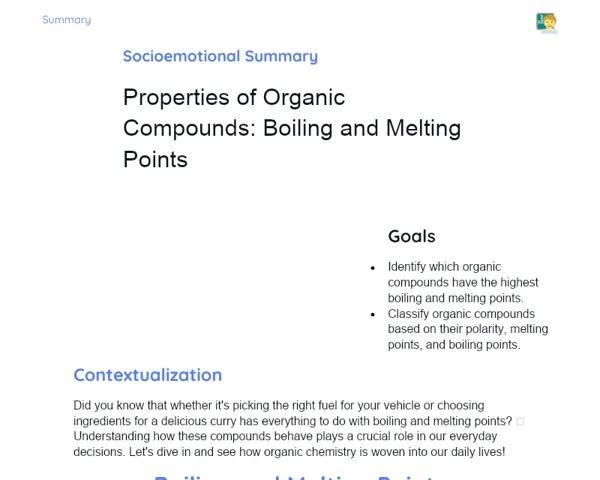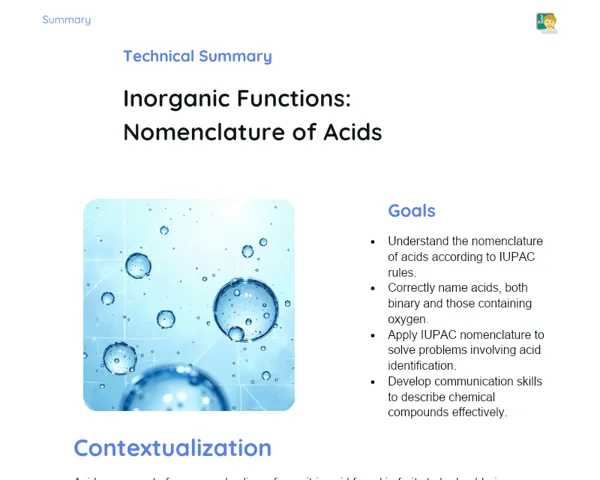Objectives
1. Identify and describe what constitutes an acid, recognizing the release of hydrogen when dissolved in water, and distinguishing acids from other chemical compounds.
2. Understand the various properties of acids and their classifications, which will empower students to apply this knowledge in practical scenarios and experiments conducted in class.
Contextualization
Did you know that acids are integral to our everyday lives and perform vital roles beyond just chemical reactions? For instance, citric acid, commonly found in citrus fruits, is not only used to enhance flavour and preserve food but also plays a part in beauty regimes and even cleaning products. This highlights the versatility and significance of acids across different facets of our lives.
Important Topics
Properties of Acids
Acids are a class of chemical substances that, when mixed with water, release hydrogen ions (H+). This fundamental trait is crucial for comprehending their properties and reactions. Acids typically have a sour taste, react with metals to produce hydrogen gas, and can corrode materials, as seen with hydrochloric acid's effect on metals.
-
Characteristic sour taste: This can be experienced in items like lemon juice and vinegar, which are rich in citric and acetic acids.
-
Reaction with metals: Acids such as hydrochloric acid react with reactive metals like zinc and iron to yield a salt and release hydrogen gas.
-
Corrosive ability: Acids can corrode various materials and are often used in cleaning agents and industrial processes for this reason.
Classification of Acids
Acids can be categorized in multiple ways, but the most common approach is based on their origin or oxygen content. Inorganic acids, like hydrochloric and sulfuric acids, generally do not contain oxygen in their chemical structure. In contrast, organic acids, like acetic and citric acids, are derived from living organisms and invariably contain carbon, and often oxygen.
-
Inorganic acids: These arise from mineral sources and typically lack oxygen, such as hydrochloric acid (HCl) and sulfuric acid (H2SO4).
-
Organic acids: These are sourced from living entities and consistently contain carbon, often bonded with hydrogen and oxygen, such as acetic acid (CH3COOH) and citric acid (C6H8O7).
-
Importance of nomenclature: Classifying acids aids in recognizing and comprehending their properties and reactions, along with practical applications.
Practical Applications of Acids
Acids serve numerous practical functions, from cooking and preserving food to applications in industry and healthcare. For example, ascorbic acid (vitamin C) acts as an antioxidant in foods and is also used in medicine. Sulfuric acid stands out as a staple in industry, vital for manufacturing fertilizers, detergents, and in oil refining.
-
Food preservation: Acids like citric acid are used to preserve food and enhance its flavour.
-
Chemical industry: Sulfuric acid is crucial in producing a variety of industrial goods, including fertilizers and detergents.
-
Healthcare: Acids such as acetylsalicylic acid (aspirin) boast analgesic and anti-inflammatory properties.
Key Terms
-
Acid: A substance that liberates hydrogen ions in water, recognized by its sour taste and its ability to react with specific metals.
-
Hydrogen (H+): A positively charged ion released by acids when in aqueous solutions, fundamental to the reactivity of acids.
-
pH: A scale measuring the acidity or basicity of a solution, ranging from 0 to 14, where 7 is neutral, below 7 is acidic, and above 7 is basic.
For Reflection
-
How does understanding the properties of acids assist in selecting methods for preserving food?
-
What is the significance of differentiating between inorganic and organic acids regarding their real-world applications and environmental effects?
-
In which ways have advancements in materials science been shaped by the exploration of acid and base properties?
Important Conclusions
-
We revisited the fundamental concept of acids, exploring their composition, properties, and classifications. We learned how acids release hydrogen ions in solutions, possess a characteristic sour taste, and interact uniquely with other materials.
-
We discussed the role of acids in our daily lives, from culinary uses to industrial applications, and how essential it is to grasp these substances across various fields, such as chemistry, biology, and engineering.
-
We underscored the importance of handling acids safely and correctly, highlighting the need for proper procedures for both handling and disposal to mitigate risks to both personal safety and the environment.
To Exercise Knowledge
- Create an 'Acid Diary': For one week, keep track of all the acids you discover at home or within your surroundings. Categorize them and note their uses. 2. Experiment 'Acid or Not?': Test various substances from your home using litmus paper to classify them as acidic, basic, or neutral. 3. 'Chemical Chef': Prepare a dish or beverage using acids and explain how they contribute to the dish's flavour or preservation.
Challenge
Acid Detective Challenge: Using safe household items such as fruits, baking soda, and vinegar, set up a small laboratory to ascertain the acidity levels of these items. Attempt to predict the outcomes before testing and elucidate the rationale behind your predictions.
Study Tips
-
Create visual associations: Link specific colours or images to different types of acids to bolster your memorization.
-
Utilise online resources: Access interactive simulations and educational videos to deepen your understanding of acid-base reactions.
-
Engage with practical problems: Solve everyday chemistry problems involving acids to reinforce your understanding.



